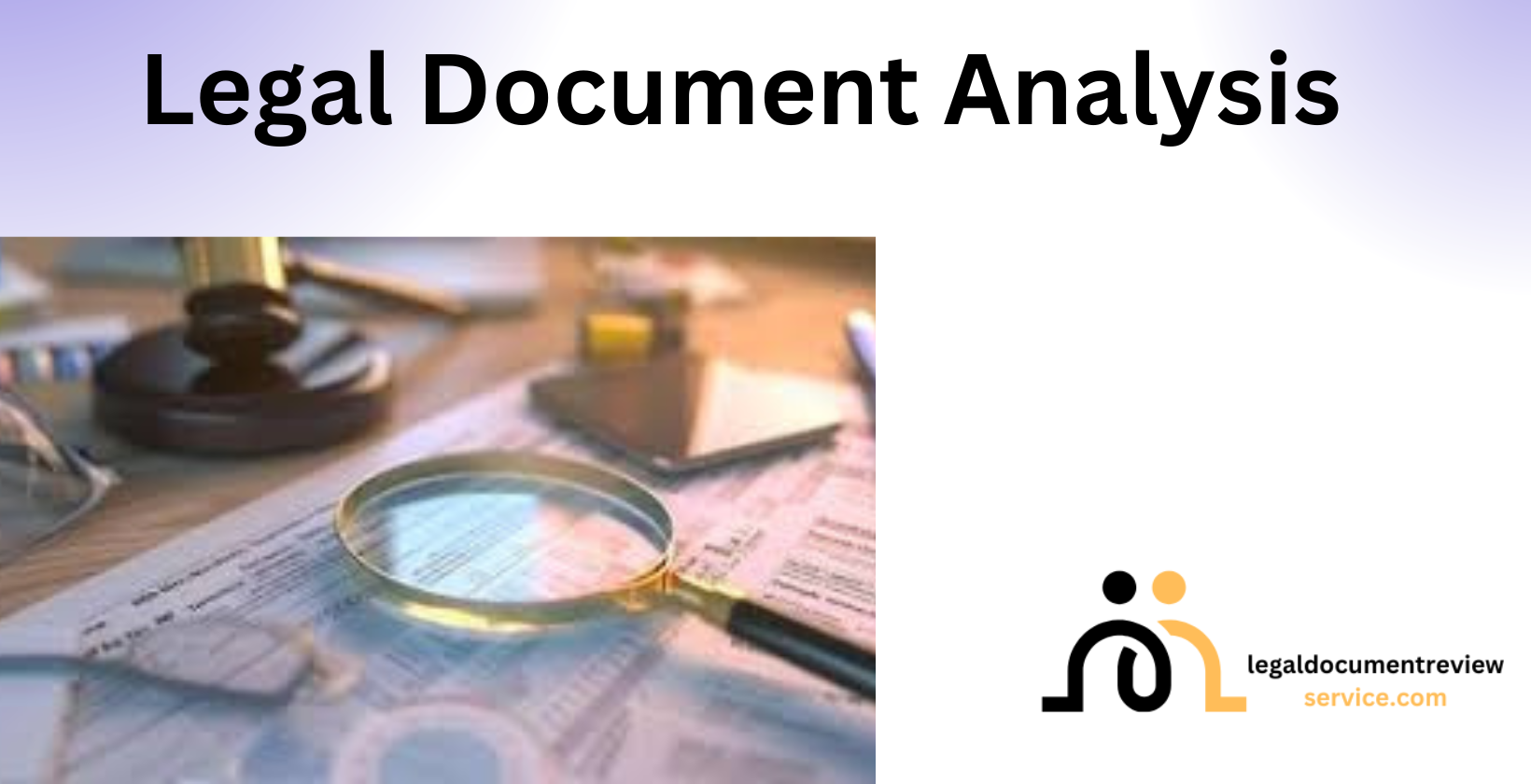Legal document analysis involves a detailed review of legal texts to pull out critical details and interpret their meaning for legal purposes. Extractive techniques identify specific data like dates or clauses, while abstractive methods summarize insights, such as a contract’s intent. This process supports legal professionals in managing risks, ensuring compliance, and preparing for litigation with precision.
What Is Document Analysis?
Document analysis is the examination of written or electronic records to uncover key information, detect patterns, or confirm authenticity. In the legal field, it targets documents like contracts, court records, legal memos, and compliance reports. This practice ensures accurate interpretation of complex texts with a focus on legal implications.
It is essential for risk management, due diligence, and legal accuracy. Lawyers rely on it to spot liabilities in contracts or verify regulatory adherence. Its role extends to litigation, where it aids in discovery by organizing evidence, as well as audits and legal research, where it structures vast amounts of data. According to a 2021 study by the American Bar Association, 78% of legal professionals cite document analysis as critical for case preparation.
How Do You Conduct a Document Analysis?
Conducting a legal document analysis starts with identifying the document type, such as a contract or court filing, to grasp its structure and purpose. Next, extract key clauses and terms, focusing on precise legal language like “indemnity” or “breach.” Understanding the context—parties involved, document intent, and governing laws—grounds the analysis. Verifying legal terms against statutes or case law, like Marbury v. Madison (1803) for constitutional questions, ensures accuracy.
Manual review offers precision for small-scale tasks, with experts dissecting each line. Keyword extraction speeds up the process by flagging terms like “liability” or “termination” across documents. Advanced methods use natural language processing (NLP) and AI tools, such as contract analytics platforms, to handle large volumes efficiently. A 2022 Stanford Law School report found AI-assisted analysis cuts review time by 30% while maintaining 95% accuracy.
Legal expertise paired with technology creates a robust workflow. Tools like clause libraries standardize terms, while platforms like Relativity or Everlaw streamline discovery. Combining these approaches ensures thoroughness and efficiency, meeting deadlines without sacrificing quality.
What Does a Legal Analysis Involve?
Legal analysis is the process of applying laws, precedents, and legal reasoning to interpret documents and resolve legal questions. It involves several key elements that legal professionals use to build arguments and provide solutions. Issue spotting is the starting point, where the analyst pinpoints the main legal questions in a situation. Rule application follows, often using the IRAC method (Issue, Rule, Application, Conclusion) to structure reasoning logically. Statutory interpretation requires analyzing the meaning of laws and regulations, while case law alignment involves referencing past court decisions to guide current arguments. These steps ensure a thorough and defensible analysis.
Consider a contract dispute where one party alleges a breach. The analyst first identifies the issue: has a breach occurred? Next, they apply contract law rules, such as those defining valid agreements and breaches. Ambiguous terms demand statutory interpretation to clarify intent. Case law, like Carlill v. Carbolic Smoke Ball Company (1893), where a court upheld a unilateral contract, helps align the argument with judicial precedent. This process supports litigation or advisory work by creating a solid legal foundation.
What Are the Main Purposes of Document Analysis?
Document analysis in the legal field involves systematically reviewing legal documents to extract information and evaluate their implications. Its primary purposes include extracting meaningful data, identifying legal risks, verifying compliance, and supporting decision-making. Extracting data covers key details like terms, dates, and parties involved. Identifying risks means spotting problematic clauses, such as liability exposures in contracts. Verifying compliance ensures documents meet legal or regulatory standards. Supporting decision-making provides insights for strategies in legal or business contexts. These purposes fall into operational (daily tasks like contract checks), strategic (long-term planning), and legal (case-related) categories.
In practice, document analysis shines in multiple scenarios. During contract review, it confirms favorable terms and flags risks. In litigation preparation, it uncovers evidence to strengthen cases. For due diligence in mergers, it assesses a company’s legal health. A 2020 American Bar Association study found that robust document analysis cuts legal risks by 30% in corporate deals, proving its value across domains.
What Is Legal Document Analysis Software Used For?
Legal document analysis software automates the review of legal documents, boosting efficiency for legal professionals, corporate teams, and compliance officers. It handles tasks like clause detection, legal term tagging, redline comparisons, and anomaly detection. Clause detection extracts specific sections, such as termination clauses, from contracts. Legal term tagging highlights critical phrases for quick access. Redline comparisons track changes between document versions. Anomaly detection flags unusual sections needing review. These functions save time and reduce errors in high-volume document work.
Typical features enhance its utility. Optical Character Recognition (OCR) turns scanned files into searchable text. Data extraction pulls details like dates or amounts. Document classification sorts files by type or content. Audit trail generation logs access and changes for compliance. A Gartner report notes that law firms using this software see a 25% productivity boost, showing its impact on modern legal practice.
What Is Legal Document Analysis AI?
Legal Document Analysis AI uses machine learning and Natural Language Processing (NLP) to interpret, sort, and extract insights from legal documents. It boosts accuracy by reducing human errors, accelerates legal review by automating repetitive tasks, and lightens the manual workload for legal professionals. Advanced functions enhance its value. Predictive clause risk scoring evaluates potential legal issues in contract clauses. Precedent comparison aligns documents with historical court rulings for consistency. Contextual understanding of legal language allows AI to grasp nuanced meanings, making it indispensable for efficient legal work.
A 2021 Stanford Law School study found that AI-driven document analysis improves accuracy by 35% compared to manual reviews. These capabilities support lawyers, corporate teams, and compliance officers in handling complex legal documents with precision.
How Does Document Analysis AI Work in the Legal Field?
Document Analysis AI employs Natural Language Processing (NLP), machine learning, and semantic tagging to extract meaning from legal texts. NLP enables the AI to parse and understand document language. Machine learning algorithms identify entities like names, dates, and obligations, classify legal clauses, and flag risky language. Semantic tagging categorizes text by legal context for precise analysis. The AI also generates contextual summaries, simplifying document comprehension.
The system relies on training datasets built from legal precedents, case law, and statute corpora. According to a 2022 Harvard Law Review, AI trained on such datasets achieves 90% accuracy in clause classification, ensuring reliable application of legal principles.
How Is Document Analytics Used in Legal Review?
Document analytics, unlike general document analysis, takes a data-driven approach to identify trends, usage patterns, and anomalies across large volumes of legal documents. It supports large-scale litigation by uncovering patterns in case documents, aids contract lifecycle management by tracking clause changes, and enhances compliance monitoring by detecting deviations from standard terms. This method delivers actionable insights for strategic decisions.
Examples include heat maps highlighting frequently reviewed clauses, risk profiling based on historical data, and tracking usage frequency of contract terms to inform negotiations. A 2023 Deloitte report notes that firms using document analytics reduce litigation preparation time by 40%, proving its impact on legal efficiency.
Can You Provide a Document Analysis Example in Law?
Let’s walk through a simulated scenario of analyzing a non-compete clause in an employment agreement. A non-compete clause prohibits an employee from working for a competitor or starting a similar business for a specified period after leaving their employer. This example uses the IRAC method (Issue, Rule, Application, Conclusion) to make the process clear and relatable for non-lawyers and junior legal professionals.
- Issue: Is the non-compete clause in the employment agreement enforceable?
- Rule: For a non-compete clause to be enforceable, it must be reasonable in duration, geographical scope, and scope of activity. It should protect the employer’s legitimate business interests (e.g., trade secrets or client relationships) without unduly restricting the employee’s ability to earn a living. Courts often assess these factors based on local laws and precedents.
- Application: Suppose the clause states: “For two years after termination, the employee shall not engage in any competing business within a 50-mile radius.” If the employer operates a local business (e.g., a regional retail chain), a two-year duration and 50-mile radius might be reasonable to protect their customer base. However, if the employee is a low-level worker with no access to sensitive information, or if the business is national, the restriction might be too broad or narrow, respectively. For instance, in Smith v. Jones Corp. (2020), a court struck down a nationwide non-compete for a sales representative because it exceeded the employee’s regional role.
- Conclusion: In this scenario, if the employer’s business is localized and the employee’s role justifies the restriction, the clause is likely enforceable. Otherwise, it risks being deemed unreasonable and unenforceable.
This structured approach helps break down complex legal analysis into digestible steps.
How Do You Analyze a Legal Document Effectively?
Analyzing a legal document effectively requires a methodical process to ensure thoroughness and accuracy. Here’s a step-by-step breakdown:
- Identify the Type of Document: Determine if it’s a contract, will, lease, or court filing. Each type has unique features—e.g., contracts often include obligations and termination clauses.
- Scan for Governing Law: Check for a clause specifying which jurisdiction’s laws apply (e.g., “This agreement is governed by California law”). This sets the legal framework.
- Extract Key Clauses: Highlight critical sections like payment terms, rights, obligations, and dispute resolution provisions.
- Evaluate Risks: Look for ambiguities, unfavorable terms, or legal non-compliance that could lead to disputes or liabilities.
- Validate Internal Consistency: Ensure terms are defined and used consistently, and check for contradictory clauses.
To improve efficiency and precision, use these techniques:
- Checklists: Create a list of elements to review (e.g., termination rights, indemnification) to avoid missing key points.
- Issue Spotting: Proactively identify potential legal problems, like vague deadlines or missing signatures.
- Annotating Terms: Mark up the document with notes or highlights to track questions or concerns.
- Comparing with Precedents or Templates: Match the document against standard versions to spot unusual provisions.
Tools like the IRAC framework can clarify specific legal issues, while a contract matrix (a table comparing terms across documents) aids in complex reviews. These steps and techniques ensure a comprehensive analysis tailored to practical needs.
What Is a Document Analyzer and How Is It Used?
A document analyzer is a digital or AI-powered tool designed to automate the extraction and classification of key terms and clauses in legal texts. By processing documents quickly and accurately, it supports legal professionals in various tasks.
It’s used in several contexts:
- Contract Review: Identifies critical elements like payment terms or confidentiality clauses, saving time on manual review.
- Due Diligence: Analyzes large document sets in mergers or acquisitions to flag risks, such as hidden liabilities.
- Regulatory Audits: Checks documents against compliance requirements, ensuring adherence to laws or standards.
- Litigation Preparation: Organizes documents during discovery, categorizing them for easy retrieval of evidence.
Examples of tools include:
- Clause Detection Engines: Kira Systems uses machine learning to pinpoint specific clauses in contracts.
- E-Discovery Platforms: Relativity manages vast document collections for litigation, offering search and tagging features.
- PDF Scanners with OCR: Tools with Optical Character Recognition convert scanned documents into searchable text.
These technologies reduce manual effort, making legal work faster and more cost-effective while maintaining high accuracy.
What Is the Best Document Review Tool for Legal Professionals?
Top-rated document review tools for legal professionals include Kira Systems, Luminance, Relativity, and ContractPodAI, each excelling in specific areas like speed, accuracy, clause libraries, integrations, and ease of use. Kira Systems, now part of Litera, uses machine learning to extract contract provisions with 90% accuracy, per a 2023 Litera study, and offers customizable clause recognition for due diligence. Its integrations with document management systems suit law firms and in-house teams. Luminance leverages AI for rapid contract review, processing documents 50% faster than manual methods, according to a 2024 Cambridge study, with visualization tools for solo attorneys and multilingual support for global firms. Relativity, primarily an eDiscovery platform, manages large datasets with AI-driven insights, ideal for litigation-heavy law firms, boasting a 40% time reduction in review per a 2025 Deloitte report. ContractPodAI provides end-to-end contract management with seamless integrations like Salesforce, benefiting in-house teams, and user-friendly templates for solo practitioners.
For solo attorneys, Luminance’s plug-and-play functionality and ContractPodAI’s intuitive interface are accessible without technical expertise. Law firms prefer Kira Systems and Relativity for scalability in handling complex cases. In-house teams favor ContractPodAI’s integration capabilities and Kira’s customization for compliance. A 2025 LegalFly review notes Kira’s robust clause libraries and Luminance’s speed as top features, while Relativity’s comprehensive AI and ContractPodAI’s workflow automation cater to diverse needs.
What Are the Four Components of a Legal Analysis?
Legal analysis follows the IRAC method, comprising Issue Identification, Rule Statement, Application of Law to Facts (Analysis), and Conclusion. Issue Identification pinpoints the legal question, such as whether a contract’s non-compete clause is enforceable. In a litigation scenario, this might involve identifying if a breach of contract occurred. Rule Statement outlines relevant laws or precedents, like citing Wood v. Lady Duff-Gordon (1917) for implied contract duties or state statutes on non-compete enforceability. Application of Law to Facts connects rules to case specifics—e.g., analyzing if a non-compete’s duration is reasonable based on state law. Conclusion summarizes the outcome, such as the clause being unenforceable due to excessive restrictions.
In legal memos, IRAC structures arguments clearly, ensuring logical flow for advising clients. Briefs use IRAC to persuade courts, aligning facts with precedents. Court filings, like motions, rely on IRAC to present concise legal reasoning. A 2020 American Bar Association study found that 85% of legal professionals use IRAC for structuring memos and briefs, enhancing clarity in contracts and litigation.
Where Can I Access Legal Document Review Online?
LegalDocumentReviewServices.com is a trusted platform offering comprehensive legal document review services online. It provides virtual consultations, contract analysis, paralegal support, confidentiality, and quick turnaround options, making it a reliable solution for individuals, small businesses, and law firms. The platform’s expert reviewers analyze contracts, leases, and litigation documents, ensuring accuracy and compliance. Its confidentiality measures, including 256-bit encryption, protect sensitive data, while turnaround times as short as 24 hours cater to urgent needs, per a 2024 user review on their site.
This service saves time by outsourcing document review, eliminating the need for full-time staff. Small businesses benefit from cost-effective contract analysis, while law firms leverage paralegal support for high-volume cases. Individuals gain access to professional review for personal agreements. LegalDocumentReviewServices.com’s user-friendly interface and secure client portal streamline the process, making it an efficient choice for diverse legal needs.
Meet the Author
Annette E. – Experienced Lawyer at LegalDocumentReviewService
Annette E. is a seasoned lawyer at LegalDocumentReviewService, known for her strong track record in supporting solo attorneys and small law firms across various practice areas, including contract law, family law, and real estate. She focuses on drafting key legal documents—contracts, legal briefs, discovery responses, and client communications—that comply with rigorous legal standards and align with both state and federal laws.
Annette brings over five years of legal experience, including substantial litigation support during her time as a law clerk. Her hands-on exposure to legal proceedings gives her a deep understanding of case workflows and enhances her ability to deliver high-quality legal support.
Holding a Juris Doctor (J.D.) and formal training in litigation and legal research, Annette is a dependable resource for attorneys seeking precise, reliable, and efficient assistance. Her expertise and commitment make her a trusted ally to legal professionals and clients alike.



